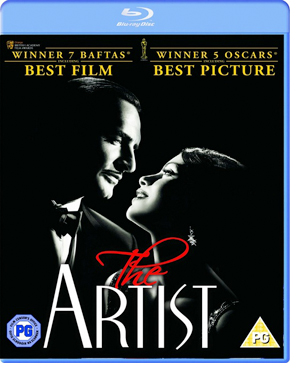 Film: The Artist (The Weinstein Co. 2011)
Film: The Artist (The Weinstein Co. 2011)
Writer/Director: Michel Hazanavicius
Cast: Jean Dujardin, Bérénice Bejo, John Goodman, James Cromwell, Penelope Ann Miller, Malcolm McDowell, Missi Pyle
Genre: Romantic comedy
?Let me tell you what I just heard. Talk, talk, talk, I. Talk, talk, talk, I. Well, what about me??
Gena Showalter, The Darkest Seduction
?Love, being dependent on the relative absence of narcissism, requires the development of humility, objectivity and reason.?
Erich Fromm, The Art of Loving
Film as Pilgrimage?or Escape?
George Valentin is a silent screen star. He’s so full of himself that he looks like an ass sometimes, but audiences adore him and shower him with the adulation he craves. His charisma wins him the love of a perky young thing whose career, partly due to his good offices, quickly surpasses his (she at least is willing to talk out loud).
In 1927, the talkies replace the silent screen. George is encouraged to continue his movie career as a talking actor, but the first time he sees a talkie he laughs at what he sees as the sheer absurdity of it. No, George does not wish to speak on film. He wants to go on expressing feelings and thoughts through gestures, postures, and facial expressions, leaving the words to the intertitles.
It’s tempting to see George Valentin, a thinly veiled spoof of Rudolph Valentino, as symbolic of the transience of the silent film age. But on a broader scale, Valentin represents film itself, or rather that element of the commercial film industry That’s consciously and deliberately escapist, that wouldn’t stand still for a profound spiritual epiphany if you paid it to. He refuses to speak because the human voice is the universally accepted vessel for communicating the true self to the world; George Valentin, if he even has a true self, is completely disconnected from it and would like it to stay that way, thank you very much.
There is something in movies that prefers the silently moving jaws, that longs to express itself with every means but speech. This is why It’s often possible to watch films in a language you don’t know, and yet still grasp what’s going on without even reading the subtitles?the visual and aural cues can be as revelatory as words.
This film was a puzzler at first. It was hard, after having watched a number of films that portrayed the unjust suppression of freedom of speech, to watch a film in which a man was given the freedom to speak and refused it. Since the time of John the Baptist, silencing someone has been tantamount to beheading?in other words, a removal of the true self.
But George Valentin is a narcissist. He doesn’t know who he really he is and doesn’t want to know; he’s content with seeing his reflection in the eyes of admiring fans. This is all that he requires to assure himself that he exists and is worthy of love. With him the suppression of verbal expression is intentional.
This is Hollywood’s dilemma. On the one hand, movies have a huge capacity to express the anxieties and confusions of the age and have thus been granted the power to, as Francesco Casetti explains, negotiate reality for the viewing public. On the other hand, film exhibits an urge to do no more than to distract and entertain, to run from problems and to escape into romance and pleasure (Valentin’s only spoken line in the film is, tellingly, ?Mon plaisir.?).
This idea of the incongruity of the two sides of the film industry coin is beautifully expressed in The Artist‘s recreation of the silent film format. It’s a remarkable achievement, especially in a movie that on the surface looks like conventional film fluff, the kind of thing our grandparents watched to forget about the Depression and the war. From The Artist:
DORIS: I’m unhappy, George.
VALENTIN: So are millions of us.
The fact that it has emerged now casts some light on the tenor of our times. Illusions are like comfort food?generally devoid of the nutrients needed for long-term health, but providing needed calories and a sense of contentment that carries us through hard times. We’ve always counted on the film industry to give us candy to suck on to stop us from crying.
It’s like in the movie True Stories, when John Goodman (who also incidentally appears in The Artist) sings, ?People like us, we don’t want justice. We don’t want freedom. We just want someone to love.? At the end of The Artist this voiceless element survives in the form of a dance that celebrates a successful escape from meaning.
Sometimes people don’t want the deep goods; they just want their basic needs met. This awful truth has burned out many a social activist (and socially conscious artist), and it puts film at odds with itself, pitting the desire to negotiate positive change against the desire to create a diversion from the very things that need to change.
Love is what in the end unites the two, allowing George to continue entertaining speechlessly, even as the talkies effectively replace silent film.
The Artist manifests six of the Mindful Bard’s criteria for films well worth seeing: 1) it is authentic, original, and delightful; 2) it poses and admirably responds to questions that have a direct bearing on my view of existence; 3) it stimulates my mind; 4) it provides respite from a sick and cruel world, a respite enabling me to renew myself for a return to mindful artistic endeavour; 5) it is about attainment of the true self; and 6) it makes me appreciate that life is a complex and rare phenomenon, making living a unique opportunity.


